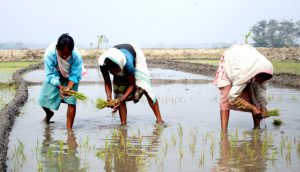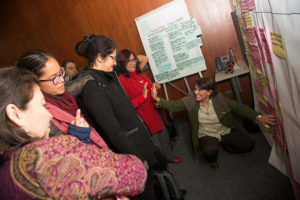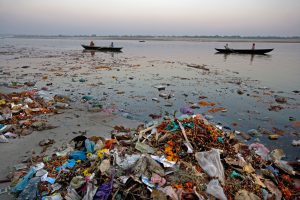This week the World Bank holds its annual meeting in Lima, Peru—the first time the Bank’s annual gathering has touched down in South America since 1967. Planned long in advance, the original idea had been to celebrate the region’s return to economic growth.
But now there is little to celebrate in the region, as Latin America’s China-led commodity boom has reached a limit and the region faces sliding growth and growing social and environmental conflict.
Riding the coattails of the China boom, between 2003 and 2013 Latin American countries grew faster than any period since the relatively high growth of the 1960s and 1970s. As a result, during the boom many countries in the region were able to erase the increases in inequality from the low growth, crisis-ridden Washington Consensus period from the 1980s to 2002—a period associated with the unpopular World Bank and International Monetary Fund (IMF) programs.
At the same time China is experiencing a bumpy transition to a more consumption-led economy and is no longer driving a global commodity boom. The decline in China’s demand for commodities, in part, explains why Latin America is projected to grow at just 0.5 percent in 2015.
While Latin American leaders must be credited for using some of the proceeds to reduce poverty and inequality during the China boom, those same leaders invested little of the proceeds to diversify into services and manufacturing activities that could have picked up the slack now that commodity prices have plateaued and even begun to fall.
The downturn gives the World Bank a second chance in Latin America. One area where the World Bank could help turn things around would be to invest more in the region’s infrastructure. The United Nations estimates that the region has a glaring infrastructure gap of 6.2 percent of GDP, a measure of what it would take in investment on an annual basis to meets its economic needs and improve the economy—a gap that, if filled, would bring the largest economic benefits, relative to other options.
A recent Inter-American Development Bank study showed that a 1 percent reduction in transport costs would increase exports by as much as 4 percent in Mexico and 7.9 percent in Colombia. The IMF says that for every dollar that goes into infrastructure it generates 1.6 dollars of new economic output and growth in the private sector.
In keeping with the newly formed Sustainable Development Goals, the World Bank could lead by example to—in the words of the Goals—“develop quality, reliable, sustainable and resilient infrastructure, including regional and trans-border infrastructure, to support economic development and human well-being, with a focus on affordable and equitable access for all.”
Chinese demand for Latin American commodities may be plateauing but China has entered a new phase in its relationship with Latin America: leading the charge on infrastructure finance. Since the financial crisis China’s two development banks—the China Development Bank and the Export-Import Bank of China—have provided four times more finance to Latin American governments than the World Bank.
Yet China is beginning to experience numerous road blocks in its infrastructure project Latin America. Difficulties of government red tape and social and environmental conflicts in Latin America—including a protest in Peru this month where police opened fire and killed protestors at a Chinese mine—have slowed or halted a number of projects. The controversial Belo Monte hydroelectric plant in Brazil, financed in part by Brazil’s national development bank and a big Chinese energy company, is proving costly: it may cost the project US$ 1.4million per day of protest and delay.
According to a new report coordinated by Boston University’s Global Economic Governance Initiative (which I co-direct) China’s newly planned projects will be even more challenging. The Twin-Ocean Railway from the Pacific (Peru) to the Atlantic (Brazil) would rip through parts of the Andes mountains and the Amazon jungle—two of the most environmentally important places on earth, containing some of the highest concentrations of indigenous peoples as well.
As we report, the good news is that the Chinese banks and companies often rise to meet or exceed social and environmental standards when pressured by governments and/or civil society. Unfortunately, rather than keeping banks and companies in check, Latin American governments have turned up the surveillance on civil society to make sure it isn’t in the way of their newfound benefactors.
The World Bank has already learned the hard way that engaging with local communities and mitigating negative environmental impacts of big infrastructure projects is not only important to a bank’s image, but also helps identify risk and protect the bottom line.
Rather than helping governments learn from these hard lessons to enable a new wave of infrastructure in the developing world, civil society organisations are organising in Lima to protest what they allege is the World Bank’s efforts to water down its own policies to compete with the new development bank architecture.
Since the World Bank can’t (and shouldn’t) beat the Chinese, it should join with the emerging development bank architecture to finance green infrastructure in a manner that is socially inclusive and environmentally sustainable. Despite paying lip-service to its intention to work with China, the World Bank has done little to reach out so far.
In 2013 Chinese financial support to the Inter-American Development Bank (IDB) created a US$ 2billion China Cofinancing Fund for Latin America and the Caribbean— a fund that quickly started two wind farms in Uruguay. The project represents a promising combination of China’s capital and infrastructure expertise combined with the IDB’s experience with the region and the IDB’s social and environmental safeguards. In contrast to the World Bank’s safeguard requirements that are part of a 14-16 month project cycle process and can be a significant cost for borrowing countries, the IDB’s projects take half that time to get off the ground and their safeguards have little impact on the length or costs of the project cycle.
The IDB reckons that Latin America will need to double its installed power infrastructure and capacity by 2030, at a cost of at least US$ 430billion. They also estimate that Latin America could produce more than six times world capacity—let alone Latin America’s—from untapped solar, wind, marine, geothermal and biomass energy in the region. The demand is there, so is the supply—but not the finance.
Given the lack of vision by Latin American governments, the lack of incentive from the private sector, and the new vision of the Sustainable Development Goals, development banks, including the World Bank, need to rise to the occasion to kick-off finance for green and inclusive growth. Working together alongside governments and civil society would give the World Bank a second chance in Latin America.
This article originally appeared on LatinAmericaGoesGlobal.
![Dal Lake, Half of Kashmi's wetlands have disappeared in the last century [mage by Athar Parvaiz]](https://dialogue.earth/content/uploads/2015/10/10-300x225.jpg)




